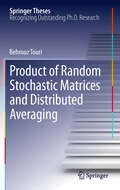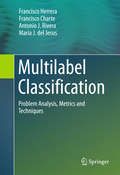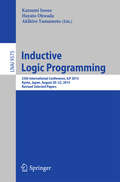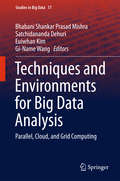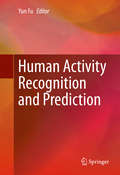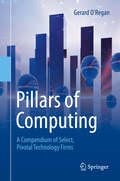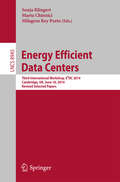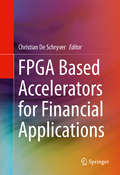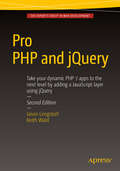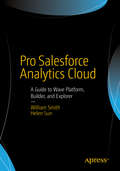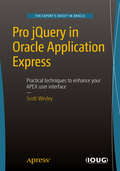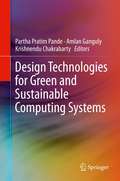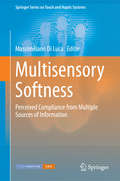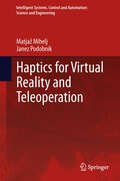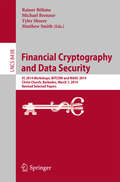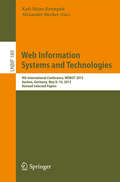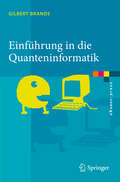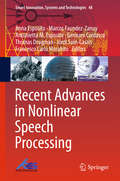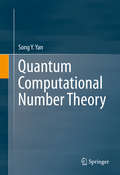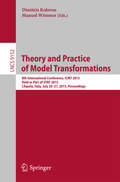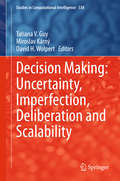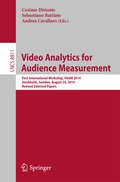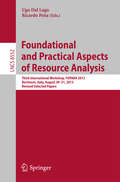- Table View
- List View
Product of Random Stochastic Matrices and Distributed Averaging
by Behrouz TouriThe thesis deals with averaging dynamics in a multiagent networked system, which is a main mechanism for diffusing the information over such networks. It arises in a wide range of applications in engineered physical networks (such as mobile communication and sensor networks), as well as social and economic networks. The thesis provides in depth study of stability and other phenomena characterizing the limiting behavior of both deterministic and random averaging dynamics. By developing new concepts, and using the tools from dynamic system theory and non-negative matrix theory, several novel fundamental results are rigorously developed. These contribute significantly to our understanding of averaging dynamics as well as to non-negative random matrix theory. The exposition, although highly rigorous and technical, is elegant and insightful, and accompanied with numerous illustrative examples, which makes this thesis work easily accessible to those just entering this field and will also be much appreciated by experts in the field.
Multilabel Classification
by Francisco Herrera Francisco Charte Antonio J. Rivera María J. JesusThis book offers a comprehensive review of multilabel techniques widely used to classify and label texts, pictures, videos and music in the Internet. A deep review of the specialized literature on the field includes the available software needed to work with this kind of data. It provides the user with the software tools needed to deal with multilabel data, as well as step by step instruction on how to use them. The main topics covered are: * The special characteristics of multi-labeled data and the metrics available to measure them. * The importance of taking advantage of label correlations to improve the results. * The different approaches followed to face multi-label classification. * The preprocessing techniques applicable to multi-label datasets. * The available software tools to work with multi-label data. This book is beneficial for professionals and researchers in a variety of fields because of the wide range of potential applications for multilabel classification. Besides its multiple applications to classify different types of online information, it is also useful in many other areas, such as genomics and biology. No previous knowledge about the subject is required. The book introduces all the needed concepts to understand multilabel data characterization, treatment and evaluation.
Inductive Logic Programming
by Katsumi Inoue Hayato Ohwada Akihiro YamamotoThis book constitutes the thoroughly refereed post-conference proceedings of the 25th International Conference on Inductive Logic Programming, ILP 2015, held in Kyoto, Japan, in August 2015. The 14 revised papers presented were carefully reviewed and selected from 44 submissions. The papers focus on topics such as theories, algorithms, representations and languages, systems and applications of ILP, and cover all areas of learning in logic, relational learning, relational data mining, statistical relational learning, multi-relational data mining, relational reinforcement learning, graph mining, connections with other learning paradigms, among others.
Techniques and Environments for Big Data Analysis
by Bhabani Shankar Prasad Mishra Satchidananda Dehuri Euiwhan Kim Gi-Name WangThis volume is aiming at a wide range of readers andresearchers in the area of Big Data by presenting the recent advances in the fieldsof Big Data Analysis, as well as the techniques and tools used to analyze it. The book includes 10 distinct chaptersproviding a concise introduction to Big Data Analysis and recent Techniques and Environments forBig Data Analysis. It gives insightinto how the expensive fitness evaluation of evolutionarylearning can play a vital role in big data analysis by adopting Parallel, Grid, and Cloud computing environments.
Human Activity Recognition and Prediction
by Yun FuThis book provides a unique view of human activity recognition, especially fine-grained human activity structure learning, human-interaction recognition, RGB-D data based action recognition, temporal decomposition, and causality learning in unconstrained human activity videos. The techniques discussed give readers tools that provide a significant improvement over existing methodologies of video content understanding by taking advantage of activity recognition. It links multiple popular research fields in computer vision, machine learning, human-centered computing, human-computer interaction, image classification, and pattern recognition. In addition, the book includes several key chapters covering multiple emerging topics in the field. Contributed by top experts and practitioners, the chapters present key topics from different angles and blend both methodology and application, composing a solid overview of the human activity recognition techniques.
Pillars of Computing
by Gerard O'ReganThis accessible compendium examines a collection of significant technology firms that have helped to shape the field of computing and its impact on society. Each company is introduced with a brief account of its history, followed by a concise account of its key contributions. The selection covers a diverse range of historical and contemporary organizations from pioneers of e-commerce to influential social media companies. Features: presents information on early computer manufacturers; reviews important mainframe and minicomputer companies; examines the contributions to the field of semiconductors made by certain companies; describes companies that have been active in developing home and personal computers; surveys notable research centers; discusses the impact of telecommunications companies and those involved in the area of enterprise software and business computing; considers the achievements of e-commerce companies; provides a review of social media companies.
Energy Efficient Data Centers
by Sonja Klingert Marta Chinnici Milagros Rey PortoThis book constitutes the thoroughly refereed post-conference proceedings of the Third International Workshop on Energy Efficient Data Centers, E2DC 2014, held in Cambridge, UK, in June 2014. The 10 revised full papers presented were carefully selected from numerous submissions. They are organized in three topical sections named: energy optimization algorithms and models, the future role of data centres in Europe and energy efficiency metrics for data centres.
FPGA Based Accelerators for Financial Applications
by Christian SchryverThis book covers the latest approaches and results from reconfigurable computing architectures employed in the finance domain. So-called field-programmable gate arrays (FPGAs) have already shown to outperform standard CPU- and GPU-based computing architectures by far, saving up to 99% of energy depending on the compute tasks. Renowned authors from financial mathematics, computer architecture and finance business introduce the readers into today's challenges in finance IT, illustrate the most advanced approaches and use cases and present currently known methodologies for integrating FPGAs in finance systems together with latest results. The complete algorithm-to-hardware flow is covered holistically, so this book serves as a hands-on guide for IT managers, researchers and quants/programmers who think about integrating FPGAs into their current IT systems.
Pro PHP and jQuery
by Jason Lengstorf Keith WaldTake advantage of the improved performance and reduced memory requirements of PHP version 7, and learn to utilize the new built-in PHP functions and features such as typed variable enforcement with declare(strict_types=1) and the new available data types, scalar type declarations for function arguments and return statements, constant arrays using define(), argument unpacking with the . . . operator, integer division with intdiv(), the null coalesce operator, the spaceship operator, new exception types, and improvements to existing features. Pro PHP and jQuery, Second Edition is for intermediate level programmers interested in building web applications using jQuery and PHP. Updated for PHP version 7 and the latest version of jQuery, this book teaches some advanced PHP techniques and it shows you how to take your dynamic applications to the next level by adding a JavaScript layer using the jQuery framework and APIs. After reading and using this book, you'll come away having built a fully functional PHP and jQuery web application that you can reapply as a template for your own particular web application. What you'll learn How to use PHP 7 to build a calendar application that allows users to post, view, edit, and delete events How to use jQuery to allow the calendar app to be viewed and edited without requiring page refreshes using built-in Ajax functions How to harness the power and versatility of PHP's object-oriented programming style How to apply the various forms of security available How to use jQuery plug-in development patterns to create modular, reusable jQuery plug-ins. How to employ jQuery effects, including fading elements, generating HTML markup on the fly, and creating modal windows Who this book is for This book is intended for programmers who want to bridge the gap between front- and back-end programming. It does not cover HTML or CSS except where absolutely necessary, and it focuses on taking intermediate PHP developers to the next level while getting comfortable with Ajax and the power of jQuery. Table of Contents 1. Introducing jQuery in PHP 2. Common jQuery Actions and Methods 3. Object-Oriented Programming 4. Build an Events Calendar 5. Add Controls to Create, Edit, and Delete Events 6. Password Protecting Sensitive Actions and Areas 7. Enhancing the User Interface with jQuery 8. Editing the Calendar with Ajax and jQuery 9. Performing Form Validation with Regular Expressions 10. Extending jQuery
Pro Salesforce Analytics Cloud
by William Smith Helen SunThis book explains Salesforce Analytics Cloud and provides a holistic view of different analytical capabilities and how they fit into the overall information architecture. It features real-world industry use cases and demonstrates how Salesforce's Analytics Cloud solves business challenges and brings real value to the organization. The Salesforce Analytics Cloud represents the rethinking of analytics for the business user. The Analytics Cloud is a cloud-based platform designed for the business user to have access to analytics "on the go," providing answers to questions instantly on any device. This mobile-ready capability of the Salesforce Analytics Cloud means users can immediately collaborate and share insights with team members right inside Salesforce. Pro Salesforce Analytics Cloud provides actionable guidance on creating analytical capabilities using Salesforce Analytics Cloud. The book offers: A practical guide to Salesforce Analytics Cloud, including Builder and Explorer. Detailed business analytics use cases in various industries (e. g. , manufacturing). Advanced architectures and best practices for integration and data discovery. What you'll learn How Salesforce Analytics Cloud delivers competitive analytics to different industries. How to implement best-fit use cases from data sources to analytical application using tools based on best practices. How to query and explore data across enterprise systems like CRM and ERP. How to easily load Excel spreadsheets, enabling user drive data exploration. How to get up and running in just a few short weeks, unlike legacy business intelligence or desktop discovery tools. How cloud capabilities fit into the overall information architecture. Who this book is for The target audience consists of business and IT professionals such as VP/directors of business intelligence and data warehousing, CIOs, CTOs, chief data officers, enterprise architects, data architects, information architects, and business and data analysts in various capacities. It's also a hands-on development guide for developers and designers of analytical systems, including IT developers and consulting professionals. Table of Contents An Overview of the Salesforce Analytics Cloud The Salesforce Analytics Cloud Explorer Analytics Cloud Builder Salesforce Analytics Platform Critical Decision Making and the Salesforce Analytics Cloud Mobile Enterprise Data Discovery Advanced Data Acquisition and Processing
Pro jQuery in Oracle Application Express
by Scott WesleyBuilding on your existing SQL skills, this book teaches you how to apply useful jQuery techniques to applications developed using the Oracle Application Express (APEX) development tool. Pro jQuery in Oracle Application Express covers the fundamentals you need to start enhancing your applications, with some practical examples that you'll want in your own applications tomorrow. jQuery is a framework already utilized by APEX, and by learning the basics of jQuery you can leverage the flexible dynamic actions provided and see your applications raise the bar. Discover why you should embrace HTML5, CSS, and jQuery library capabilities, and how they can enhance the user experience. Oracle Application Express is a mature, browser-based, rapid-development environment with a strong community base around the #orclapex tag. jQuery is a language for the browser, with it you can treat your web page as if it were a database, interacting with a range of features and functions that can make you into a more constructive, more efficient developer. Exemplifies how productive APEX, CSS, and jQuery can be Transforms your PL/SQL skills to CSS and jQuery Provides jQuery snippets to enhance your application UX What you'll learn Learn the basics of CSS and the jQuery toolset Use inbuilt browser tools to your advantage Apply basic patterns for common scenarios Integrate browser events with database processes Adapt examples suitable for touch screen environments Remember performance and design considerations Who this book is for Pro jQuery in Oracle Application Express is for Oracle Applicaton Express (APEX) developers who want to impress their clients with simple but effective techniques that make applications stand out. The book is an excellent choice for even those who feel they've mastered dynamic actions, as the use of jQuery provides even greater flexibility to manage page events - particularly for tablet devices. Readers don't need to be a JavaScript experts to start applying some examples provided. The book is written with the PL/SQL programmer in mind. Table of Contents Part I: Getting Started Chapter 1: CSS - The Secret Chapter 2: jQuery Fundamentals Chapter 3: Browser Tools Part II: Integrating into APEX Chapter 4: Enlarging Content Chapter 5: Firing Dynamic Actions Chapter 6: jQuery Alternatives to Dynamic Actions Chapter 7: Highlight Selected Rows Chapter 8: Add Button to Report Part III: Playing with Processes Chapter 9: Process Options Chapter 10: Linking a Checkbox to a Collection Chapter 11: Using jQuery Dialogs Chapter 12: Using Modal Forms Chapter 13: Receiving Information from the Database Part IV: Reporting Options Chapter 14: Adding Visualisation with JSON Chapter 15: Applying jQuery Post-Render Chapter 16: Clicking Entire Rows Chapter 17: Customizing Pagination Part V: Diversifying Techniques Chapter 18: Customizing Help Chapter 19: Validating from the File Browse Widget Chapter 20: Writing Media Queries Chapter 21: Conclusion
Design Technologies for Green and Sustainable Computing Systems
by Krishnendu Chakrabarty Amlan Ganguly Partha Pratim PandeThis book provides a comprehensive guide to the design of sustainable and green computing systems (GSC). Coverage includes important breakthroughs in various aspects of GSC, including multi-core architectures, interconnection technology, data centers, high performance computing (HPC), and sensor networks. The authors address the challenges of power efficiency and sustainability in various contexts, including system design, computer architecture, programming languages, compilers and networking.
Multisensory Softness
by Massimiliano Di LucaOffers a unique multidisciplinary overview of how humans interact with soft objects and how multiple sensory signals are used to perceive material properties, with an emphasis on object deformability. The authors describe a range of setups that have been employed to study and exploit sensory signals involved in interactions with compliant objects as well as techniques to simulate and modulate softness - including a psychophysical perspective of the field. Multisensory Softness focuses on the cognitive mechanisms underlying the use of multiple sources of information in softness perception. Divided into three sections, the first Perceptual Softness deals with the sensory components and computational requirements of softness perception, the second Sensorimotor Softness looks at the motor components of the interaction with soft objects and the final part Artificial Softness focuses on the identification of exploitable guidelines to help replicate softness in artificial environments.
Adaptive Web Design: Crafting Rich Experiences with Progressive Enhancement
by Aaron GustafsonBuilding an elegant, functional website requires more than just knowing how to code. In Adaptive Web Design, Second Edition, you'll learn how to use progressive enhancement to build websites that work anywhere, won't break, are accessible by anyone--on any device--and are designed to work well into the future. This new edition of Adaptive Web Design frames even more of the web design process in the lens of progressive enhancement. You will learn how content strategy, UX, HTML, CSS, responsive web design, JavaScript, server-side programming, and performance optimization all come together in the service of users on whatever device they happen to use to access the web. Understanding progressive enhancement will make you a better web professional, whether you're a content strategist, information architect, UX designer, visual designer, front-end developer, back-end developer, or project manager. It will enable you to visualize experience as a continuum and craft interfaces that are capable of reaching more users while simultaneously costing less money to develop. When you've mastered the tenets and concepts of this book, you will see the web in a whole new way and gain web design superpowers that will make you invaluable to your employer, clients, and the web as a whole. Visit http://adaptivewebdesign. info to learn more.
Haptics for Virtual Reality and Teleoperation
by Matjaž Mihelj Janez PodobnikThis book covers all topics relevant for the design of haptic interfaces and teleoperation systems. The book provides the basic knowledge required for understanding more complex approaches and more importantly it introduces all issues that must be considered for designing efficient and safe haptic interfaces. Topics covered in this book provide insight into all relevant components of a haptic system. The reader is guided from understanding the virtual reality concept to the final goal of being able to design haptic interfaces for specific tasks such as nanomanipulation. The introduction chapter positions the haptic interfaces within the virtual reality context. In order to design haptic interfaces that will comply with human capabilities at least basic understanding of human sensors-motor system is required. An overview of this topic is provided in the chapter related to human haptics. The book does not try to introduce the state-of-the-art haptic interface solutions because these tend to change quickly. Only a careful selection of different kinematic configurations is shown to introduce the reader into this field. Mathematical models of virtual environment, collision detection and force rendering topics are strongly interrelated and are described in the next two chapters. The interaction with the virtual environment is simulated with a haptic interface. Impedance and admittance based approaches to haptic robot control are presented. Stability issues of haptic interaction are analyzed in details and solutions are proposed for guaranteeing stable and safe operation. Finally, haptic interaction is extended to teleoperation systems. Virtual fixtures which improve the teleoperation and human-robot cooperation in complex environments are covered next and the last chapter presents nanomanipulation as one specific example of teleoperation.
Econometric Analysis of Carbon Markets: The European Union Emissions Trading Scheme and the Clean Development Mechanism
by Julien ChevallierThrough analysis of the European Union Emissions Trading Scheme (EU ETS) and the Clean Development Mechanism (CDM), this book demonstrates how to use a variety of econometric techniques to analyze the evolving and expanding carbon markets sphere, techniques that can be extrapolated to the worldwide marketplace. It features stylized facts about carbon markets from an economics perspective, as well as covering key aspects of pricing strategies, risk and portfolio management.
Financial Cryptography and Data Security
by Michael Brenner Matthew Smith Rainer Böhme Tyler MooreThis books constitutes the thoroughly refereed papers and poster abstracts from the FC 2014 Workshops, the First Workshop on Bitcoin Research, BITCOIN 2014, and the Second Workshop on Applied Homomorphic Cryptography and Encrypted Computing, WAHC 2014, co-located with the 18th International Conference on Financial Cryptography and Data Security, held in Christ Church, Barbados, on March 7, 2014. The 15 full papers and 3 poster abstracts presented were carefully reviewed and selected from 30 submissions. They are grouped in topical sections on Bitcoin transactions, policy and legal issues; Bitcoin security; improving digital currencies; posters, and WAHC papers.
Web Information Systems and Technologies
by Karl-Heinz Krempels Alexander StockerThis book contains the thoroughly refereed and revised best papers from the 9th International Conference on Web Information Systems and Technologies, WEBIST 2013, held in Aachen, Germany, in May 2013, organized by the Institute for Systems and Technologies of Information, Control and Communication (INSTICC), and co-organized by the RWTH Aachen University. The 15 papers presented in this book were carefully reviewed and selected from 143 submissions. The papers were selected from those with the best reviews also taking into account the quality of their presentation at the conference. The papers are grouped into parts on Internet technology, Web interfaces and applications, society, e-business and e-government, Web intelligence, and mobile information systems.
Einführung in die Quanteninformatik
by Gilbert BrandsAusgehend von der Theorie und den Protokollen der Quantenkryptografie werden in dem Band die Servicequalitäten vorgestellt, die angesichts der aktuellen technischen Möglichkeiten erreichbar sind. Unter Berücksichtigung wenig beachteter Gesichtspunkte der Kryptoanalyse diskutiert der Autor die erreichbare Sicherheit und untersucht die Möglichkeiten des Quantencomputing. Anhand praxisnaher Aufgaben können Leser ihr Wissen vertiefen und lernen, die Techniken kritisch zu bewerten. Mit Programmieranleitung für Simulationsversuche auf dem eigenen Rechner.
Recent Advances in Nonlinear Speech Processing
by Anna Esposito Marcos Faundez-Zanuy Antonietta M. Esposito Gennaro Cordasco Thomas Drugman Jordi Solé-Casals Francesco Carlo MorabitoThis book presents recent advances in nonlinearspeech processing beyond nonlinear techniques. It shows that it exploitsheuristic and psychological models of human interaction in order to succeed inthe implementations of socially believable VUIs and applications for humanhealth and psychological support. The book takes into account themultifunctional role of speech and what is "outside of the box" (see BjörnSchuller's foreword). To this aim, the book is organized in 6 sections, eachcollecting a small number of short chapters reporting advances "inside" and"outside" themes related to nonlinear speech research. The themes emphasizetheoretical and practical issues for modelling socially believable speechinterfaces, ranging from efforts to capture the nature of sound changes inlinguistic contexts and the timing nature of speech; labors to identify anddetect speech features that help in the diagnosis of psychological and neuronaldisease, attempts to improve the effectiveness and performance of Voice UserInterfaces, new front-end algorithms for the coding/decoding of effective andcomputationally efficient acoustic and linguistic speech representations, aswell as investigations capturing the social nature of speech in signalingpersonality traits, emotions and improving human machine interactions.
Quantum Computational Number Theory
by Song Y. YanThis book provides a comprehensive introduction to advanced topics in the computational and algorithmic aspects of number theory, focusing on applications in cryptography. Readers will learn to develop fast algorithms, including quantum algorithms, to solve various classic and modern number theoretic problems. Key problems include prime number generation, primality testing, integer factorization, discrete logarithms, elliptic curve arithmetic, conjecture and numerical verification. The author discusses quantum algorithms for solving the Integer Factorization Problem (IFP), the Discrete Logarithm Problem (DLP), and the Elliptic Curve Discrete Logarithm Problem (ECDLP) and for attacking IFP, DLP and ECDLP based cryptographic systems. Chapters also cover various other quantum algorithms for Pell's equation, principal ideal, unit group, class group, Gauss sums, prime counting function, Riemann's hypothesis and the BSD conjecture. Quantum Computational Number Theory is self-contained and intended to be used either as a graduate text in computing, communications and mathematics, or as a basic reference in the related fields. Number theorists, cryptographers and professionals working in quantum computing, cryptography and network security will find this book a valuable asset.
Theory and Practice of Model Transformations
by Dimitris Kolovos Manuel WimmerThis book constitutes the refereed proceedings of the 8th International Conference on Model Transformation, ICMT 2015, held in L'Aquila, Italy, in July 2015, as Part of STAF 2015, the federation of a number of the leading conferences on software technologies. The 16 revised papers were carefully selected from 34 submissions. The papers are organized in topical sections on change management; reuse and industrial applications; new paradigms for model transformation; transformation validation and verification; and foundations of model transformation.
Decision Making: Uncertainty, Imperfection, Deliberation and Scalability
by Tatiana V. Guy Miroslav Kárný David H. WolpertThis volume focuses on uncovering the fundamental forces underlying dynamic decision making among multiple interacting, imperfect and selsh decision makers. The chapters are written by leading experts from different disciplines, all considering the many sources of imperfection in decision making, and always with an eye to decreasing the myriad discrepancies between theory and real world human decision making. Topics addressed include uncertainty, deliberation cost and the complexity arising from the inherent large computational scale of decision making in these systems. In particular, analyses and experiments are presented which concern: * task allocation to maximize "the wisdom of the crowd"; * design of a society of "edutainment" robots who account for one anothers' emotional states; * recognizing and counteracting seemingly non-rational human decision making; * coping with extreme scale when learning causality in networks; * efciently incorporating expert knowledge in personalized medicine; * the effects of personality on risky decision making. The volume is a valuable source for researchers, graduate students and practitioners in machine learning, stochastic control, robotics, and economics, among other elds.
Video Analytics for Audience Measurement
by Andrea Cavallaro Cosimo Distante Sebastiano BattiatoThis book constitutes the refereed contest reports of the 1st International Workshop, VAAM 2014, held in Stockholm, Sweden, in August 2014. The 10 revised full papers presented were carefully reviewed and selected from 13 submissions. The aim of this workshop is to provide an overview of state of the art methods for audience measurements in retail and Digital Signage, end-users attraction, and stimulate the creation of appropriate benchmark dataset to be used as reference for the development of novel audience measurement algorithms. Papers are invited under the following topics: demographics and modeling consumer behaviour.
Foundational and Practical Aspects of Resource Analysis
by Ugo Dal Lago Ricardo PeñaThis book constitutes the proceedings of the Third International Workshop on Foundational and Practical Aspects of Resource Analysis, FOPARA 2013, held in Bertinoro, Italy, in August 2013. The 9 papers presented in this volume were carefully reviewed and selected from 12 submissions. They deal with traditional approaches to complexity analysis, differential privacy, and probabilistic analysis of programs.
